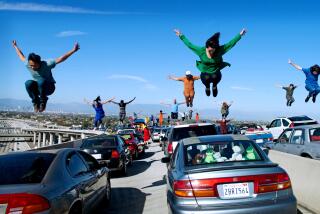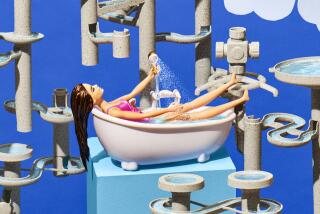Artist envisions water wheel transforming a stretch of L.A. River
An artist and a director of the Annenberg Foundation is seeking permission to build a 70-foot water wheel to draw water from the Los Angeles River north of Chinatown to create a stream and shady retreat for the public.
The idea is to transform one of the most heavily industrialized stretches of the river into a slice of sylvan tranquillity, said artist Lauren Bon, granddaughter of the late Walter Annenberg, a publishing magnate and philanthropist.
“If we succeed, people 100 years from now will wonder how a water wheel and giant canopy of cottonwoods somehow escaped the explosive industrial growth of Los Angeles,” Bon said.
The entire cost, estimated at $10 million, would be borne by Metabolic Studio, a direct charitable activity of the Annenberg Foundation, one of the world’s largest family philanthropic organizations. Bon is the director of Metabolic Studio.
The water wheel and landscaping would be situated on about an acre just outside Metabolic Studio, on the west side of the L.A. River between North Broadway and Spring Street. The land is owned by the Los Angeles County Metropolitan Transportation Authority, which is in talks with the studio about the proposal.
“It sounds fascinating,” said Dave Sotero, a Metro spokesman. “It’s an artistic statement and a utilitarian project all at once.”
The U.S. Army Corps of Engineers is considering Metabolic Studio’s application for a permit to take water from the river, which has served for decades as a flood-control channel. It is one of at least two dozen permits needed to start construction.
If all goes according to plan, within two years a steel and aluminum water wheel, half of it visible above ground, will raise 80 gallons of water per minute from the river. A small portion would go for a stream several hundred feet long and landscaped with native plants, including cottonwood trees.
Other water would go into a distribution network of pipes leading to treatment facilities and storage areas for irrigation of city and regional parks, including the nearby 32-acre Los Angeles State Historic Park.
Bon calls the idea “bending the river back into the city.” She said the project would serve as a symbolic reminder that Los Angeles will always have to rely on limited water supplies delivered over long distances.
“This is a legacy piece for us,” she said. “Our goal is to inspire people to think in new ways about where our water comes from and how it is used.”
Eventually, Bon said, the stream could be lengthened to run parallel to the river channel to Long Beach, about 25 miles south of downtown.
For now, the studio has much work to do.
“It’s easier to permit a National Football League stadium downtown than to secure water rights for a water wheel next to the L.A. River,” mused Michael Gagan, a public affairs specialist hired to help Bon win approval from regulatory and municipal agencies including the Los Angeles Bureau of Engineering, the state Water Resources Control Board, the Los Angeles County Flood Control District, the Southern California Regional Rail Authority, the U.S. Fish and Wildlife Service and Metro.
“Los Angeles is a complicated city from a permitting standpoint,” Gagan said. “But it can be navigated. And the water wheel captures the imaginations of regulators accustomed to saying no.”
Jay Field, spokesman for the Army Corps of Engineers, said the agency will evaluate the proposal thoroughly to ensure that it would not diminish the river’s ability to control floods.
Mark Hanna, a hydrologist with Geosyntec Consultants, which has been hired by Metabolic Studio to help design the project, said that an inflatable dam across the river would create an impoundment area holding water to a depth of 6 feet, creating enough pressure to propel 30 cubic feet of water per second into a 42-inch, 160-foot-long tunnel burrowed through the river channel’s concrete wall.
On the other side, the water would turn the wheel twice a minute, lifting 40 buckets each rotation with the contents spilling into the distribution network. “More than 99% of the water will return to the river,” Hanna said.
Bon described that process as “avant-garde nostalgia: using an ancient technology in the city’s historic core as a paradigm for future water use.” A century ago, a smaller wooden water wheel in the same area fed a web of downtown irrigation ditches.
Metabolic Studio recently awarded more than $1 million in grants for educational, environmental and community enhancement projects along the 233-mile-long Los Angeles Aqueduct. For example, the Paiute-Shoshone Reservation in the Owens Valley community of Lone Pine, about 180 miles north of Los Angeles, received funding for efforts aimed at preserving and protecting the tribe’s cultural heritage.
Seated beside a wooden model of a water wheel on an office work bench, Bon said the stream and greenery would be named “‘The Delta of Mt. Whitney,’ as an homage to the eastern Sierra range, the source of much of our water.”
More to Read
Sign up for Essential California
The most important California stories and recommendations in your inbox every morning.
You may occasionally receive promotional content from the Los Angeles Times.











